Kutz M. Handbook of materials selection
Подождите немного. Документ загружается.


628 CERAMICS TESTING
generated during machining would cause an internal error. Another example of
an internal error would be excessive specimen deflection during testing. Support
point frictional forces at large deflections will have a component aligned with
the applied force that will increase the applied moment. ‘‘External’’ errors are
those classified as being caused by incorrect test fixture geometry. Improper
location of the inner load points is an example that causes external error. Another
example is the generation of torque on the test specimen. This can be caused
by an initially twisted test specimen, unparallel line loads, or nonuniform line
loads at the contact points.
5,6
External error can also occur from compressive
contact stresses at the support pins, which can result in localized crushing. This
error can be reduced by using support pins above a critical radius r
c
.
3
To minimize the errors associated with flexure testing, the test specimen and
test fixtures must adhere to certain restraints and standards. Test specimen ge-
ometry has been standardized based on error considerations. A common ge-
ometry in the United States is 3 by 4 by 50 mm for the test specimen and inner
and outer spans of 20 and 40 mm, respectively, for the fixtures.
7
The test spec-
imen must be isotropic and homogeneous to apply the maximum tensile stress
equation previously given. In addition, the specimen should be as free as possible
of surface defects as the maximum tensile stress occurs on the surface.
In comparing the three- and four-point flexure test methods, it is found that
the four-point method is more appropriate for determining fracture strength be-
cause no shear stresses are generated as in the three-point test method. The three-
point test method with its simpler geometry, however, may be more attractive
for tests in which stable crack growth must be induced into the test specimen.
3
Some of the flexure test standards that are applicable to advanced ceramics
are listed here:
JISC, ‘‘Testing Method for Flexural Strength (Modulus or Rupture) of Fine
Ceramics,’’ R1601-1995
JISC, ‘‘Testing Method for Flexural Strength of Fin Ceramics at Elevated
Temperature,’’ R1604-1995
ASTM, ‘‘Standard Test Method for Flexural Strength of Advanced Ceramics
at Ambient Temperatures,’’ C1161-94
ASTM, ‘‘Standard Test Method for Flexural Strength of Advanced Ceramics
at Elevated Temperatures,’’ C1211-92
Comite´ Europe´en de Normalisation (CEN),* ‘‘Advanced Technical Ceram-
ics—Monolithic Ceramics—Mechanical Properties at Room Tempera-
ture—Part 1: Determination of Flexural Strength,’’ EN843—1:1995
CEN, ‘‘Advanced Technical Ceramics—Monolithic Ceramics—Thermo-
mechanical Properties—Part 1: Determination of Flexural Strength at
Elevated Temperature,’’ ENV820—1:1993.
2.2 Creep
Similar to the fracture testing methods previously discussed, the three test meth-
ods used to determine creep characteristics in ceramics are the tensile, com-
* Comite´ Europe´en de Normalisation, Brussels, Belgium.
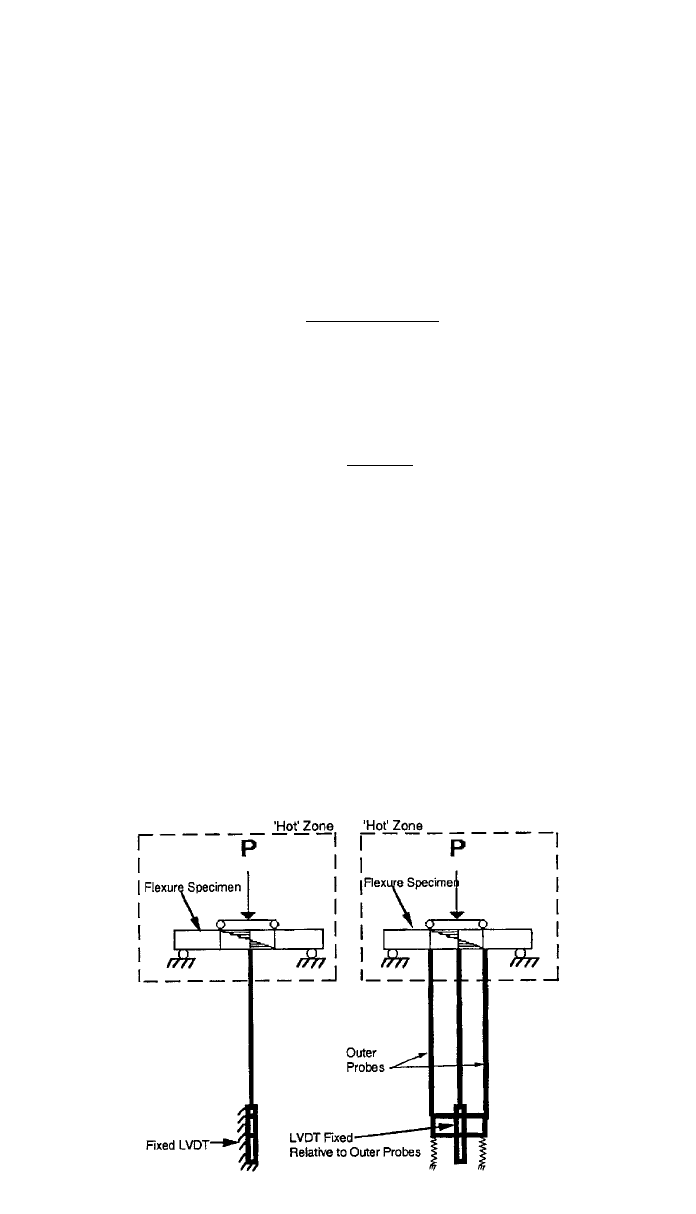
2 MECHANICAL TESTING 629
Fig. 3 Schematic of typical test setup for creep testing in flexure. (From Ref. 3 by courtesy of
Marcel Dekker Inc.)
pressive, and flexural tests. The primary differences in the test fixtures are that
the gauge section must be heated to the desired elevated temperature and an
alternate method of measuring deflection such as extensometers must be em-
ployed because of the increased temperature. Figure 3 shows a typical test setup
for a flexure test that utilizes extensometers.
Flexure Creep
Flexure testing using four-point loading yields the maximum tensile stress of a
beam in bending given in the fracture strength section:
1.5P (L
⫺ L )
ƒo i
S ⫽
ƒ
2
bh
In addition, the maximum tensile strain equation is given as:
4h
␦
center
⫽
max
2
(L )
i
Compared to the tensile and compressive creep tests, flexure testing is less
expensive, easier to design, and requires less test specimen preparation. How-
ever, the nonuniform stress state induced in the flexure testing results in difficulty
in determining the creep characteristics of a material if it deforms differently in
tension than in compression. This difference in tensile and compressive creep
behavior is a result of cavitation among other factors. Conducting an additional
test in either compression or tension allows for the determination of uniform
stress-state creep characteristics from the nonuniform flexure test results. Ad-
ditional errors from twisting, friction between test specimen and load points,
and excessive contact stress at support points are also considerations.

630 CERAMICS TESTING
Tensile Creep
Tensile testing to determine creep characteristics yields a uniform stress state
characterized by the equation:
P
⫽
gs
A
The uniform stress state eliminates the problem of different deformations in
tension and compression. This results in the much simpler calculation of stress
and strain than with flexure testing. The test setup, however, is more expensive
and difficult to implement. The test specimens required for creep tensile testing
are also more difficult and time intensive to design and manufacture. In addition
to stress gradients from the test specimen geometry, temperature differences
induce an unwanted temperature gradient in the specimen from the grip contact
portion of the specimen to the heated gauge section.
3
This temperature gradient
becomes larger and poses more of a problem when cold grips are used. Un-
wanted failure in the grip interface portion of the specimen can also be a prob-
lem. Various test standards are applicable to tensile testing of advanced ceramics.
ASTM C1291-95 directly applies to tensile testing for creep behaviors:
ASTM, ‘‘Standard Test Method for Elevated Temperature Tensile Creep
Strain, Creep Strain Rate, and Creep Time to Failure for Advanced Mon-
olithic Ceramics,’’ C1291-95
ASTM, ‘‘Standard Test Method for Tensile Strength of Monolithic Advanced
Ceramics at Elevated Temperatures,’’ C1366-95
ASTM, ‘‘Standard Test Method for Monotonic Tensile Strength Testing of
Continuous Fibre-Reinforced Advanced Ceramics with Solid Rectangular
Cross-Sections at Elevated Temperatures,’’ C1359-96
Compressive Creep
Compressive testing to determine creep behavior, like tensile testing, results in
a uniform stress state that allows for easy determination of creep characteristics.
It has been shown that creep in compression can vary significantly from creep
in tension so it is of value to conduct both tests to ‘‘get the best picture’’ of a
material’s creep properties. Some advantages to the compressive test are the low
cost in preparing the material as well as the small geometry of the specimen,
which allows for more testing per sample material size.
There are some drawbacks to the compressive test as well. The test specimen
must be aligned to a greater accuracy than tension or flexure tests to prevent
unwanted bending and buckling. End constraints on the test specimen can result
in shear stresses if the specimen ends are constrained, which results in a non-
uniform stress state. In addition, temperature gradients can have an adverse effect
on test result accuracy.
2.3 Hardness
Hardness is an important property to quantify in ceramics. Measured hardness
indicates the ability of the ceramic to resist deformation by a hard object. Usu-
ally, Knoop or Vickers diamond indenters are used in conjunction with a mi-

2 MECHANICAL TESTING 631
Fig. 4 Typical hardness versus load (force) plot. (From Ref. 8 ASM Handbook, Vol. 8: Mechani-
cal Testing and Evaluation, ASM International, Materials Park, OH 44073-0002, Fig. 3, page 245.)
croindentation hardness machine.
8
Rarely are the popular Rockwell and Brinell
indenters used for ceramics research. Vickers indenters are used to characterize
roughly 60% of the ceramic hardness values that are published.
8
The indentation force should always be included with the hardness value. For
the most accurate results, the entire force versus hardness curve should be mea-
sured as shown in Fig. 4.
Discrepancies can arise at different indentation forces. At higher forces, crack-
ing can complicate the measuring process or make measuring impossible.
8
Mea-
suring the hardness from the indentation, especially at small forces, is also a
significant source of error in hardness testing. The hardness value can change
based on the force value applied to the test specimen at small forces. Volume 8
of the ASM Handbook
8
recommends forces greater than or equal to 9.8 N for
Vickers and Knoop indentations. Errors in the measurement of the indentation
diagonal length essentially double the hardness error as the hardness value is
proportional to the square of the diagonal length. A Versailles Advanced Ma-
terials and Standards (VAMS) round-robin test project conducted on alumina
ceramic samples resulted in uncertainty in the hardness values given by the
laboratories involved.
9
Although using numerous indentations can reduce some
of this uncertainty, engineers and scientists conducting hardness tests should
nevertheless keep this uncertainty in mind when considering their data.
Standards for measuring hardness for ceramics are listed below:
Vickers Hardness
ASTM, ‘‘Standard Test Method for Vickers Indentation Hardness of Ad-
vanced Ceramics,’’ C1427-97
CEN, ‘‘Advanced Technical Ceramics—Monolithic Ceramics—Mechanical
Properties at Room Temperature—Part 4: Determination of Vickers, Knoop
and Rockwell Superficial Hardness Tests,’’ prEN834-4
JISC, ‘‘Testing Method for Vickers Hardness of High Performance Ceramics,’’
R1610:1991

632 CERAMICS TESTING
ISO, ‘‘Fine Ceramics (Advanced Ceramics, Advanced Technical Ceramics)—
Test Method for Hardness of Monolithic Ceramics at Room Temperature,’’
ISO 14705:2000
Knoop Hardness
ASTM, ‘‘Standard Test Method for Knoop Indentation Hardness of Advanced
Ceramics,’’ C1426-99
CEN, ‘‘Advanced Technical Ceramics—Monolithic Ceramics—Mechanical
Properties at Room Temperature—Part 4: Determination of Vickers, Knoop
and Rockwell Superficial Hardness Tests,’’ prEN834-4
ISO, ‘‘Fine Ceramics (Advanced Ceramics, Advanced Technical Ceramics)—
Test Method for Hardness of Monolithic Ceramics at Room Temperature,’’
ISO 14705:2000
ISO, ‘‘Glass and Glass-Ceramics—Knoop Hardness Test,’’ ISO 9385-1990.
2.4 Fracture Toughness
The brittle nature of ceramics results in low resistance to fracture, quantificial
as fracture toughness, which is an important factor in many applications of
ceramics. Fracture toughness is a measure of a specimen’s ability to resist further
growth of a crack. Low fracture toughness values increase the risk of cata-
strophic failure of a ceramic component. Ceramic matrix composites (CMCs)
have better fracture toughness compared to monolithic ceramics as the additional
reinforcing elements help to deter crack growth. The concepts of the linear-
elastic fracture mechanics (LEFM) method commonly used for other materials
can be applied to monolithic ceramics for the purpose of analysis. For ceramic
matrix composites, ongoing research is being conducted regarding the applica-
tion of the concepts of elastic-plastic fracture mechanics (EPFM) methods.
10
There are various testing methods and setups for fracture toughness testing.
Some methods included in the testing standard, ASTM C1421, are the single-
edge precracked beam (SEPB) method, the surface crack in flexure (SCF)
method, and the chevron notched beam (CNB) method.
The SEPB, SCF, and CNB methods all consist of a flexural test of a beam in
which a short straight crack is induced into the tensile side. The primary differ-
ences are the methods by which the beam is deformed to introduce the prelim-
inary short crack. All three methods have good calibration characteristics but
have some drawbacks as well. With the SEPB method, it can be difficult to
obtain straight-fronted cracks. Crack initiation in CNB testing can be difficult
as a result of residual stresses from machining. SCF testing can only be per-
formed on materials that produce high-quality cracks from the indentation.
10
Standards organizations have introduced fracture toughness testing standards
utilizing various testing methods. For example, ASTM C1421 generally uses a
flexure test of a cracked bend bar while JIS R1607 utilizes only two test methods,
SEPB and IF (indentation fracture). Standards that apply directly to fracture
toughness testing of ceramics are given below.
Japanese Industrial Standards Committee, ‘‘Testing Methods for the Fracture
Toughness of High Performance Ceramics,’’ JIS R1607-1990

2 MECHANICAL TESTING 633
Fig. 5 Test setup schematic for traditional split Hopkinson pressure bar testing. (From Ref. 11
ASM Handbook, Vol. 8: Mechanical Testing and Evaluation, ASM International,
Materials Park, OH 44073-0002, Fig. 1, page 497.)
American Society for Testing Materials, ‘‘Standard Test Methods for the De-
termination of Fracture Toughness of Advanced Ceramics at Ambient Tem-
perature,’’ ASTM C1421-99
International Organization for Standardization, ‘‘Fine Ceramics (Advanced
Ceramics, Advanced Technical Ceramics)—Test Method for Fracture
Toughness of Monolithic Ceramics at Room Temperature by Single Edge
Pre-Cracked Beam (SEPB) Method,’’ ISO DIS15732 (in 1999)
2.5 High Strain Rate
Split Hopkinson pressure bar (SHPB) testing has primarily been used in the past
to measure the plastic properties of metals. The fact that ceramics are brittle and
many ceramic compounds and alloys show only elastic strains before fracture
makes accurate testing and measurement more difficult than with more ductile
materials such as metals.
A traditional SHPB test configuration is shown in Fig. 5.
11
The test setup
consists of an incident bar, a transmission bar, and a striker bar. The ceramic
test specimen is placed in between the incident and transmission bars as shown.
The striker bar strikes the incident bar at a predetermined velocity by being
launched from a gas gun. When it impacts the incident bar, it generates a com-
pressive pulse that continues to travel to the test specimen. Part of the incident
pulse travels through the test specimen, and the remaining part is reflected back
into the incident bar. The stress pulses are measured by strain gauges placed at
midpoints on the transmission and incident bars. An oscilloscope displays the
measured pulses. The stress, strain, and strain rate equations are given as
12
:
AE
oo
(t) ⫽ (t)
sT
A
s
2c
o
˙ ⫽⫺ (t)
sR
l
s
t
(t) ⫽ 冕 ˙ (t) dt
ss
0
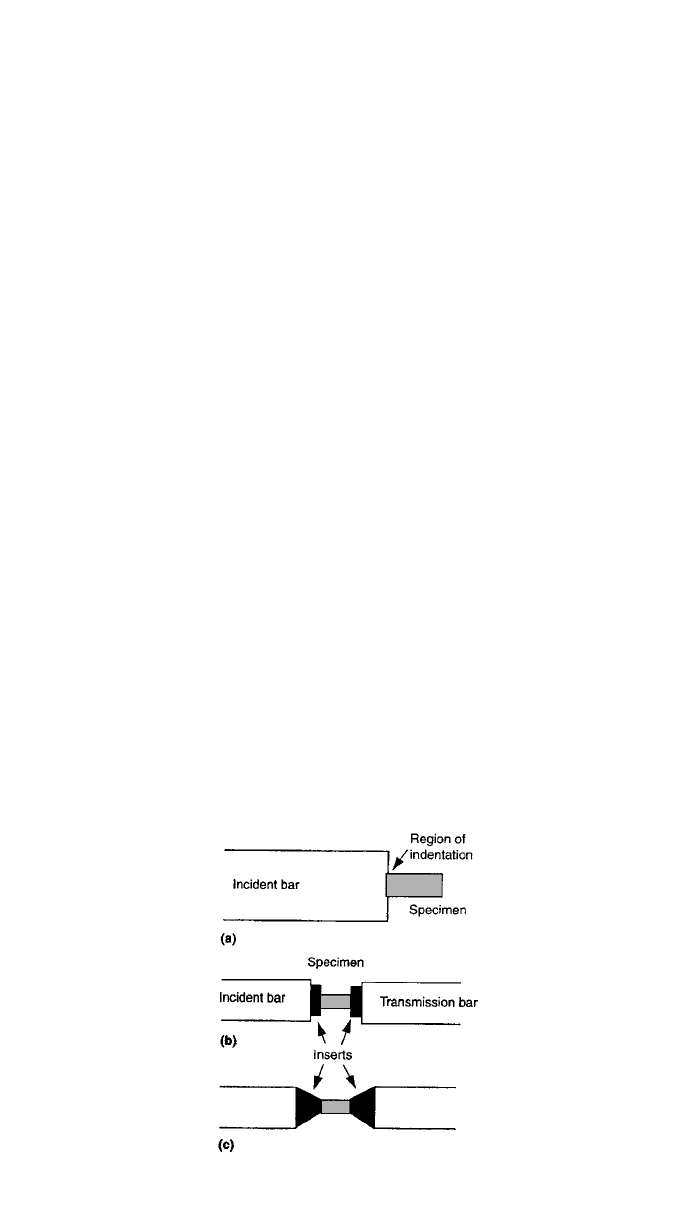
634 CERAMICS TESTING
Fig. 6 Incident bar and transmission bar protection using tungsten–carbide inserts. (From Ref.
11 ASM Handbook, Vol. 8: Mechanical Testing and Evaluation, ASM International,
Materials Park, OH 44073-0002, Fig. 3, page 499.)
where E is Young’s modulus, l is length, A is cross-sectional area,
is stress,
is strain, is strain rate, and t is time. Subscripts T, s, o, and R refer to the˙
transmitted pulse, specimen, bar, and reflected pulse.
Some of the inherent properties of ceramics such as brittleness and high
strength, conflict with assumptions that are made in deriving the stress, strain,
and strain rate equations.
11
An example is the assumption that the bar end sur-
faces remain flat and parallel during the deformation of the test specimen. The
hard nature of ceramics can cause the test specimen to indent into the steel bar
ends, resulting in stress concentration around the test specimen end faces. These
stress concentrations result in nonuniform, nonuniaxial stress state in the test
specimen, which violates another assumption in using the equations, which is
that the stress state is uniform and uniaxial. The stress concentrations can con-
sequently lead to chipping and failure of the ceramic test specimen through
microcrack initiation.
One way to minimize the problem of test specimen damage is to place tung-
sten–carbide inserts in between the test specimen and bar ends as shown in Fig.
6.
11
The high strength of the inserts prevents the ceramic test specimen from
indenting into the incident and transmission bars, thereby reducing stress con-
centrations. However, the tungsten–carbide inserts can have the adverse effect
of altering the incident, transmitted, and reflected stress-wave properties that can
result in inaccurate strain gauge measurements. This can be prevented by se-
lecting tungsten–carbide inserts with the same impedance as the bar material.
Selection of the diameter of the inserts can also help solve this problem. Typi-
cally, the insert lengths are one fourth of the test specimen length.
11
2.6 Fatigue
Fatigue testing is an important design tool for the designer of ceramic compo-
nents where reliability and lifetime estimates need to be made. Fatigue tests for
ceramics generally cover the three situations of cyclic fatigue, static fatigue, and
dynamic fatigue.
13
Cyclic fatigue is the periodic loading of a component under
various load ratios usually denoted as R:
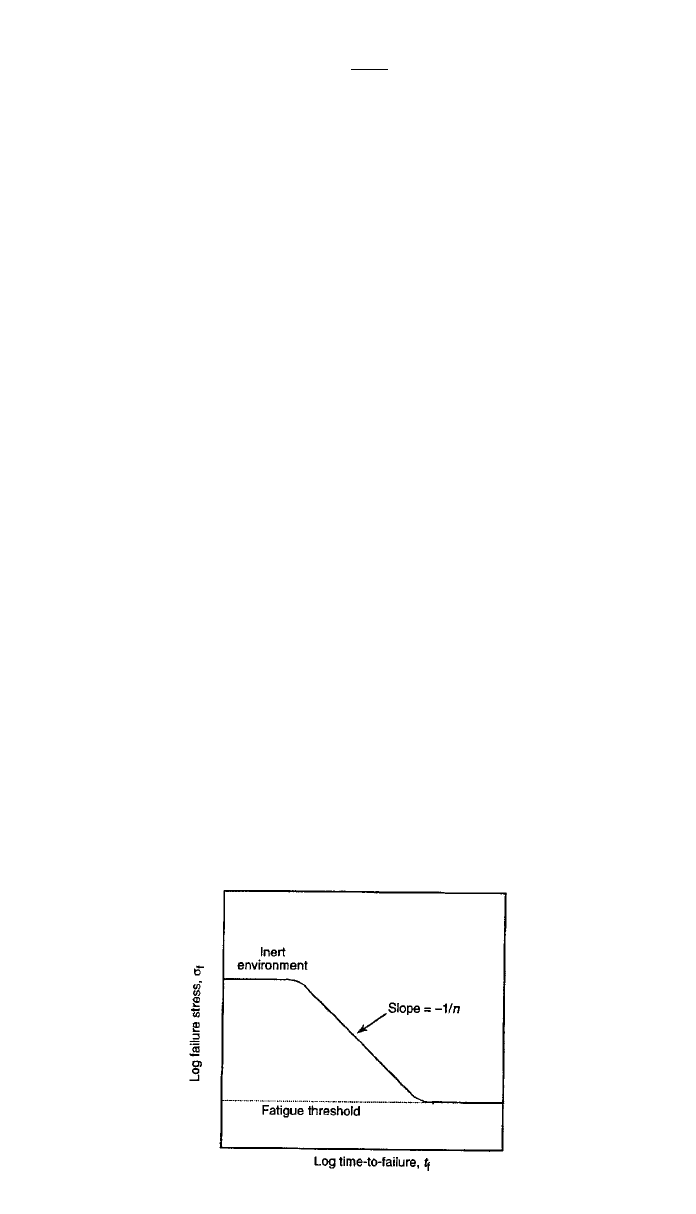
2 MECHANICAL TESTING 635
Fig. 7 Failure stress versus time to failure. (From Ref. 14 ASM Handbook, Vol. 8: Mechanical
Testing and Evaluation, ASM International, Materials Park, OH 44073-0002.)
min
R ⫽
max
Common scenarios for the stress ratio include R ⬎ 0 (both minimum and max-
imum stresses in tension or compression) and R
⬍ 0 (minimum stress in
compression and maximum stress in tension). The simple loading scenario would
involve a sinusoidal loading that varied continuously with a minimum and max-
imum stress. In real-world examples, however, the loading can be much more
complicated.
Static fatigue testing involves slow crack growth of a test specimen with a
constant tensile force under the desired conditions. The length of time for the
test specimen to fail and the applied stress are measured and used to obtain the
fatigue characteristics by using various fatigue equations. Dynamic fatigue test-
ing involves applying a constant, increasing stress (i.e., constant nonzero stress
rate) to a test specimen under desired conditions. The stress rate and maximum
applied stress at failure are measured and used in conjunction with various fa-
tigue equations to determine the fatigue characteristics.
Fatigue testing can further be divided into the two categories of ‘‘direct’’ and
‘‘indirect.’’ Direct methods, also known as fracture mechanics methods, involve
running tests with test specimens with previously induced cracks and directly
observing crack growth. Indirect methods, also known as strength measurement
techniques, involve measuring the strength of the test specimen over time inter-
vals and using the data to estimate fatigue properties.
Indirect Methods
Static loading utilizing the indirect method involves subjecting a tensile or flex-
ure test specimen to a constant load under the desired environment conditions.
The applied force stress and the amount of time for specimen failure are mea-
sured and used to estimate the fatigue properties of the ceramic material. A
typical plot of failure stress versus time to failure is shown in Fig. 7.
Uniaxial flexural tests in three- or four-point loading situations are performed
under the directions given in JIS R1601, ‘‘Test Method for Flexural Strength
(Modulus of Rupture) of Fine Ceramics.’’ At least three levels of stress are
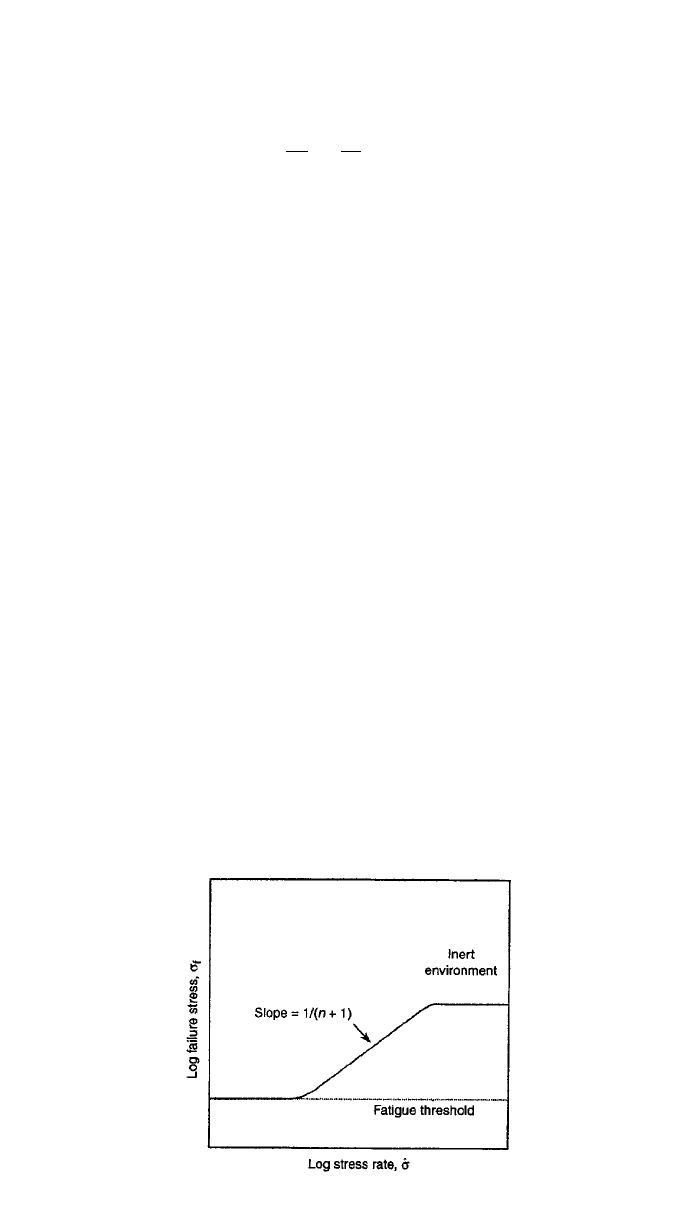
636 CERAMICS TESTING
Fig. 8 Failure stress versus stress rate. (From Ref. 14 ASM Handbook, Vol. 8: Mechanical Test-
ing and Evaluation, ASM International, Materials Park, OH 44073-0002.)
recommended. The fatigue strength can be related to the failure time with the
following equation
14
:
n
⫺
2
B
i
t ⫽⫺1
冋冉 冊 册
ƒ
2
ƒƒ
where B is a variable determined from crack geometry, fracture toughness, load-
ing situation, and K and n, which are material and environment constants;
i
is
the inert strength at which no crack extension occurs for noncorrosive conditions.
Indirect dynamic loading usually involves tensile or flexure test specimens
subjected to a constant stress rate. The applied stress rate and the failure stress
are measured and used to estimate fatigue properties. Figure 8 shows a typical
plot of failure stress versus the stress rate.
The standard, ASTM C1368, gives guidelines for fatigue strength estimating
via dynamic loading. It involves four-point flexure testing of a ceramic specimen
in accordance with ASTM C1161 ‘‘Standard Test Method for Flexural Strength
of Advanced Ceramics at Ambient Temperature.’’ The fatigue strength and ap-
plied stress rate are related by the equation
14
:
n
⫺
21/n
⫹
1
⫽ [B(n ⫹ 1)
˙
]
ƒi
where the same variable definitions apply as in the static loading equation.
There are various methods for applying periodic loads to ceramics. With
bending fatigue tests, a periodic force with a specified frequency and stress ratio
is applied to three- or four-point flexure test setups. Cyclic tensile fatigue tests
involve cyclically loading a test specimen with a testing apparatus with specified
load ratio and frequency. Various test specimen shapes can be used and tension–
compression cyclic fatigue (stress ratio
⬍ 0) has been performed utilizing a
button-head specimen and clamping fixture. Rotary bending is also used for
fatigue testing ceramics and is especially useful for analyzing components such
as shafts that undergo similar stress states while in use.
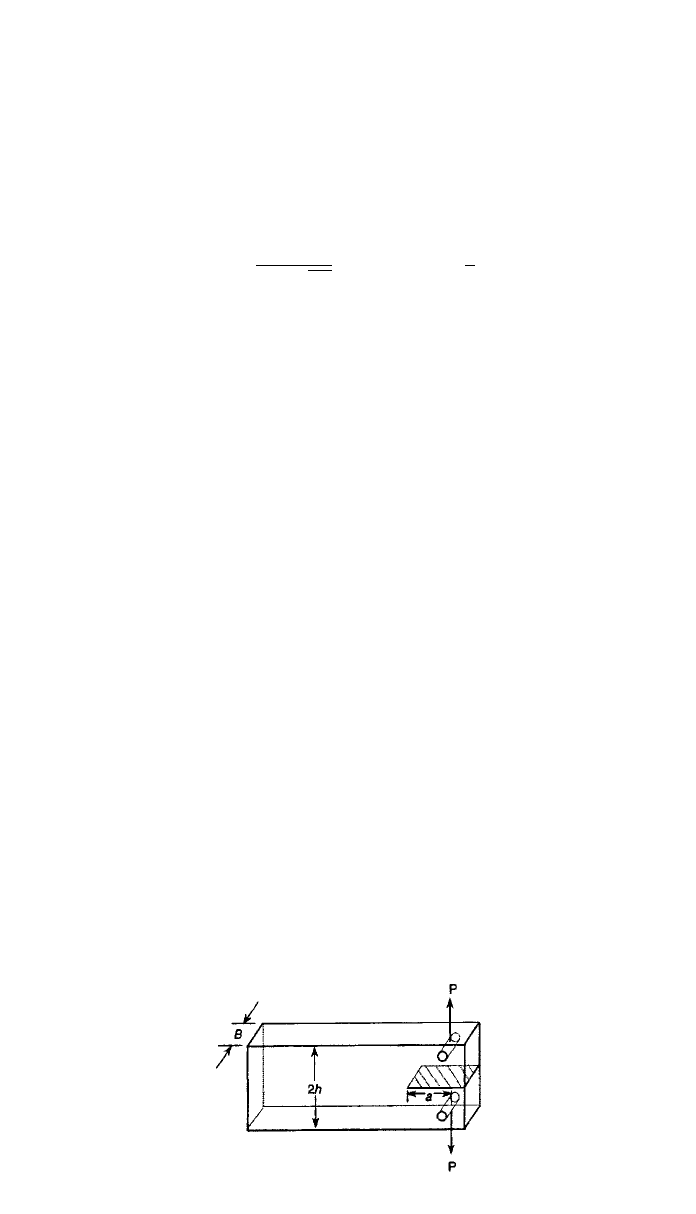
3 THERMAL TESTING 637
Fig. 9 Double-cantilever beam test method. (From Ref. 14 ASM Handbook, Vol. 8: Mechanical
Testing and Evaluation, ASM International, Materials Park, OH 44073-0002.)
Direct Methods
Direct methods, also known as fracture mechanics methods, use fatigue tests
that employ test specimens with an induced crack.
14
Crack growth is observed
directly or via strain gauges or other measuring devices.
One testing technique is the double-cantilever beam method, shown sche-
matically in Fig. 9. For the configuration shown, the stress-intensity factor and
fracture toughness can be found utilizing the equation
14
Pa h
K ⫽ 3.47 ⫹ 2.32
冉冊
l
3/2
a
h
兹Bb
where B is the thickness of the test specimen, b is the web thickness, a is the
crack length, h is half the specimen height, and P is the applied force. Some
standards that directly apply to fatigue testing of ceramics are given below.
●
Japanese Industrial Standards Committee, ‘‘Test Methods for Static Bend-
ing Fatigue of Fine Ceramics,’’ JIS R1632—1998
●
Japanese Industrial Standards Committee, ‘‘Test Method for Flexural
Strength,’’ JIS R1601—1995
●
American Society for Testing Materials, ‘‘Standard Test Method for De-
termination of Slow Crack Growth Parameters of Advanced Ceramics by
Constant Stress-Rate Flexural Testing at Ambient Temperature,’’ ASTM
C1368-99
●
American Society for Testing Materials, ‘‘Standard Test Method for Flex-
ural Strength of Advanced Ceramics at Ambient Temperature,’’ ASTM
C1161-99
●
Japanese Industrial Standards Committee, ‘‘Test Method for Bending Fa-
tigue of Fine Ceramics,’’ JIS R1621—1996
●
American Society for Testing Materials, ‘‘Standard Test Method for Flex-
ural Strength of Advanced Ceramics at Elevated Temperatures,’’ ASTM
C1211-95
3 THERMAL TESTING
3.1 Thermal Expansion
Thermal expansion is an important property that quantifies the volume change
a material undergoes when it is subjected to temperature changes. Typically,
